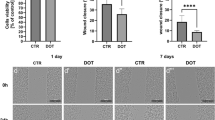Abstract
Purpose
Stem cell therapy seems to be a new treatment option within cardiac diseases to improve myocardial perfusion and function. However, the delivery and traceability of the cells represent a problem. Radioactive labelling with 111In could be a method for tracking mesenchymal stem cells (MSCs). However, 111In could influence the viability and differentiation capacity of MSCs, which would limit its use. Therefore, the aim of this study was to evaluate the influence of 111In labelling in doses relevant for SPECT imaging in humans on the viability and differentiation capacity of human MSCs.
Methods and results
Human MSCs isolated from bone marrow were incubated with 111In-tropolone (15–800 Bq/cell). The labelling efficiency was approximately 25% with 30 Bq/cell 111In. The MSC doubling time was 1.04±0.1 days and was not influenced by 111In within the range 15–260 Bq/cell. Using 30 Bq 111In/cell it was possible to label MSCs to a level relevant for clinical scintigraphic use. With this dose, 111In had no effect on characteristic surface and intracellular markers of cultured MSCs analysed both by flow cytometry and by real-time polymerase chain reaction. Further, the labelled MSCs differentiated towards endothelial cells and formed vascular structures.
Conclusion
It is possible to label human MSCs with 111In for scintigraphic tracking of stem cells delivered to the heart in clinical trials without affecting the viability and differentiation capacity of the MSCs. This creates an important tool for the control of stem cell delivery and dose response in clinical cardiovascular trials.





Similar content being viewed by others
References
Strauer BE, Brehm M, Zeus T, Kostering M, Hernandez A, Sorg RV, et al. Repair of infarcted myocardium by autologous intracoronary mononuclear bone marrow cell transplantation in human. Circulation 2002;106:1913–8
Stamm C, Westphal B, Kleine HD, Petzsch M, Kittner C, Klinge H, et al. Autologous bone-marrow stem-cell transplantation for myocardial regeneration. Lancet 2003;361:45–6
Tse H-F, Kwong Y-L, Chan JKF, Lo G, Ho CL, Lau CP, et al. Angiogenesis in ischemic myocardium by intramyocardial autologous bone marrow mononuclear cell implantation. Lancet 2003;361:47–9
Perin EC, Dohmann HF, Borojevic R, Silva SA, Sousa AL, Mesquita CT, et al. Transendocardial, autologous bone marrow cell transplantation for severe chronic ischemic heart failure. Circulation 2003;107:2294–302
Fuchs S, Satler LF, Kornowski R, Okubagzi P, Weisz G, Baffour R, et al. Catheter-based autologous bone marrow myocardial injection in no-option patients with advanced coronary artery disease. A feasibility study. J Am Coll Cardiol 2003;41:1721–4
Schächinger V, Assmus B, Britten MB, Honold J, Lehmann R, Teupe C, et al. Transplantation of progenitor cells and regeneration enhancement in acute myocardial infarction. Final one-year results of the TOPCARE-AMI trial. J Am Coll Cardiol 2004;44:1690–9
Wollert KC, Meyer GP, Lotz J, Ringes-Lichtenberg S, Lippolt P, Breidenbach C, et al. Intracoronary autologous bone-marrow cell transfer after myocardial infarction: the BOOST randomised controlled clinical trial. Lancet 2004;364:141–8
Kuethe F, Richartz BM, Sayer HG, Kasper C, Werner GS, Hoffken K, et al. Lack of regeneration of myocardium by autologous intracoronary mononuclear bone marrow cell transplantation in humans with large anterior myocardial infarctions. Int J Cardiol 2004;97:123–7
Pittenger MF, Martin BJ. Mesenchymal stem cells and their potential as cardiac therapeutics. Circ Res 2004;95:9–20
Oswald J, Boxberger S, Jorgensen B, Feldmann S, Ehninger G, Bornhauser M, et al. Mesenchymal stem cell can be differentiated into endothelial cells in vitro. Stem Cells 2004;22:377–84
Silva GV, Litovsky S, Assad JA, Sousa AL, Martin BJ, Vela D, et al. Mesenchymal stem cells differentiate into an endothelial phenotype, enhance vascular density, and improve heart function in a canine chronic ischemia model. Circulation 2005;111:150–6
Kalka C, Masuda H, Takahashi T, Kalka-Moll WM, Silver M, Kearney M, et al. Transplantation of ex vivo expanded endothelial progenitor cells for therapeutic neovascularization. Proc Natl Acad Sci U S A 2000;97:3422–7
Chin BB, Nakamoto Y, Bulte JWM, Pittenger MF, Wahl R, Kraitchman DL, et al. 111In oxine labelled mesenchymal stem cell SPECT after intravenous administration in myocardial infarction. Nucl Med Commun 2003;24:1149–54
Aicher A, Brenner W, Zuhayra M, Badorff C, Massoudi S, Assmus B, et al. Assessment of the tissue distribution of transplanted human endothelial progenitor cells by radioactive labelling. Circulation 2003;107:2134–9
Hofmann M, Wollert KC, Meyer GP, Menke A, Arseniev L, Hertenstein B, et al. Monitoring of bone marrow cell homing into infarcted myocardium. Circulation 2005;111:2198–2202
Becker W, Meller J. The role of nuclear medicine in infection and inflammation. Lancet Infect Dis 2001;1:326–33
Eggert AA, Schreurs MW, Boerman OC, Oyen WJ, de Boer AJ, Punt CJ, et al. Biodistribution and vaccine efficiency of murine dendritic cells are dependent on the route of administration. Cancer Res 1999;59:3340–5
Bohnen NI, Charron M, Reyes J, Rubinstein W, Strom SC, Swanson D, et al. Use of 111indium-labeled hepatocytes to determine the biodistribution of transplanted hepatocytes through portal vein infusion. Clin Nucl Med 2000;25:447–50
Mancuso P, Burlini A, Pruneri G, Goldhirsch A, Martinelli G, Bertolini F, et al. Resting and activated endothelial cells are increased in the peripheral blood of cancer patients. Blood 2001;97:3658–61
Brenner W, Aicher A, Eckey T, Massoudi S, Zuhayra M, Koehl U, et al. 111In-labeled CD34+ hematopoietic progenitor cells in a rat myocardial infarction model. J Nucl Med 2004;45:512–8
Limaye V, Li X, Hahn C, Xia P, Berndt MC, Vadas MA, et al. Sphingosine kinase-1 enhances endothelial cell survival through a PECAM-1-dependent activation of PI-3K/Akt regulation of Bcl-2 family members. Blood 2005;105:3169–77
Acknowledgements
This study was supported by the Lundbeck Foundation and the Research Foundation at Rigshospitalet.
Author information
Authors and Affiliations
Corresponding author
Rights and permissions
About this article
Cite this article
Bindslev, L., Haack-Sørensen, M., Bisgaard, K. et al. Labelling of human mesenchymal stem cells with indium-111 for SPECT imaging: effect on cell proliferation and differentiation. Eur J Nucl Med Mol Imaging 33, 1171–1177 (2006). https://doi.org/10.1007/s00259-006-0093-7
Received:
Accepted:
Published:
Issue Date:
DOI: https://doi.org/10.1007/s00259-006-0093-7




